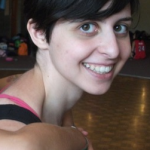Director Stanley Kubrick was once mesmerized by Napoleon Bonaparte and hired a team of historians to develop a card catalogue of his daily minutiae. The film, though believed to be an oeuvre grandiose, was never realized. Happily, choreographer John Neumeier’s similar obsession with “Le Dieu de la Danse”, Vaslav Nijinsky, has crystallized into the National Ballet of Canada’s production Nijinsky, which opened on Wednesday, November 22 at Toronto’s Four Seasons Centre.
This two-act memory ballet is a psychological odyssey that extends far beneath the surface of the sensitive, legendary dance genius. Neumeier designed, if not all, most of the visual elements: choreography, costumes, sets and lighting. Act I opens in the ivory-coloured ballroom of a Swiss hotel on January 19, 1919, where a small group of dancers arrive as guests to see what was to be Nijinsky’s final public performance. Their chuckles and chatters punctuate the intermittent absence of music. In a red velvet dress, Nijinsky’s wife Romola (Heather Odgen) weaves her sorrow through the light-hearted gathering. She gazes at Nijinsky (Guillaume Côté) who, cocooned in a white and gold cape, treads down the stairs with the pride of a reserved king, and soon unwraps his extreme neuroticism. The solemn chords from Chopin’s Prélude in C Minor, “Funeral March”, presage a tragedy.
Nijinsky’s angular movements crescendo with emotional instability. He raises his arms to his chest, and swings them against each other almost mechanically, like two pendulums in a Newton’s cradle receiving and transferring momentum with meticulous precision. Behind his fists, a distorted smile reveals a blazing soul. Estrangement fills the air, and in the melancholic lights, Nijinsky hallucinates his former lover, the impresario Diaghilev (Evan McKie), towering among the guests.
From here, Neumeier opts for a stream of consciousness approach to frame his narrative. The non-chronological, ceaseless flux of Nijinsky’s recollections intertwines with his most prominent roles. Cadenzas of Harlequin in Les Sylphides, the Golden Slave in Schéhérazade, the Spectre de la rose, the Young Man in Jeux, the Faun in L’Après-midi d’un Faune and Petruschka portrayed by different soloists, are juxtaposed with chromatic dynamism, transcending space and time. The Faun, vivified by Francesco Gabriele Frola, resembles a climactic pairing of Apoxyomenos (heroic strength) and Antinous (erotic beauty) in Greek sculpture. Noticeably, in Nikolai Rimsky-Korsokov’s Schéhérazade, Op. 35, the violin and the harp often stir Nijinsky into a fresh flow of neurotic thoughts. Those unfamiliar with Nijinsky’s anguished life face a challenge – program notes offer minimal insight into an exotic, movable feast.
Serenity is rare, but does emerge ephemerally in Nijinsky and Romola’s first encounter during an ocean voyage. With a fan in hand, Nijinsky dances with sheer flamboyance – airy gestures and flirtatious gazes, like a prince’s – and Romola responds in sinuous movements. Behind them, five backdrops of nuanced shades of blue depict the sea, their subtle variation reminiscent of Montreal artist Guido Molinari’s painting Quantificateur Bleu. Diaghilev knocks them down one by one, with bold strides. Nijinsky’s memory then seems to be broken into a thousand mirrors, as his former selves return to the stage, haunting him.
Act II probes deeper into a quagmire. The pas de deux between Nijinsky and his deranged brother Stanislav (Dylan Tedaldi) evokes a poignant climax. Stanislav’s ultimate convulsions are gut-wrenching harbingers of Nijinsky’s own tragic fate. Whenever one thinks Romola’s comforting gestures can tranquilize his roaring psychosis, Nijinsky thrusts her away; he thrashes himself relentlessly against the stage floor. Soon a mass of uniformed World War I soldiers march and swagger to besiege him, and he is emotionally drained in their hysterical howls; his avatar, Petruschka, lies lifelessly against the side wall – both enveloped in Shostakovich’s foreboding melodies. Nijinsky’s madness amid the writhing mass of soldiers’ bodies rages toward the imperfection of the world, for this tormented soul has been devoting himself to avant-garde fantasies.
Nijinsky’s career, embroidered with notoriety, lasted less than a decade. Neumeier revitalizes Nijinsky from the shadows of schizophrenia, from the ashes of time; he directs Diaghilev to cradle Nijinsky in his arms, more than once. Is it an attempt to preserve Nijinsky’s innocence? Have we become better in shielding a delicate soul from destructive prejudice? Nijinsky provokes resonant contemplations. Another tortured soul, Oscar Wilde wrote, “it is love … that is the true explanation of this world ….” He died in 1900, the very same year Nijinsky, ten or eleven years old, embarked for the Imperial Ballet School. At that age, Neumeier, for the first time, laid eyes on a Nijinsky biography, devoured it, and never forgot.
Neumeier transforms his passion into Nijinsky, and Côté pours raw vigour into this role with absolute virtuosity. It is an enthralling, sensational ballet that unveils convoluted folds of Nijinsky’s disintegrated inner self in response to the outer world. For ballet aficionados who truly appreciate profundity, it also explores the ultimate answer to life.
The National Ballet of Canada performs Nijinsky from November 22 through 26 at the Four Seasons Centre for the Performing Arts, Toronto.






